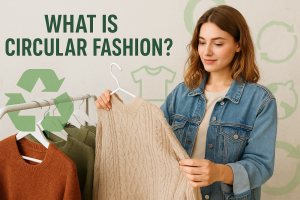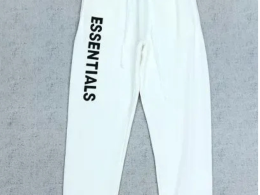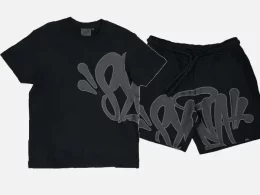Introduction
Fashion offers endless creativity, yet it often generates substantial waste. Each year, millions of garments are discarded into landfills, inflicting severe damage on our environment. Circular fashion seeks to overturn this paradigm. Rather than relegating clothing to the trash heap, circular fashion extends the lifespan of each piece, thereby mitigating our ecological footprint.
When envisioning a sustainable wardrobe, you might imagine a curated collection of durable essentials that you reach for repeatedly. You prioritize pieces constructed from high-quality materials designed for longevity. As items begin to show signs of wear, you opt for repairs or upcycling instead of discarding them. You adopt a mindful shopping strategy to sidestep the pitfalls of fast fashion industrial companies. By embracing these deliberate practices, you contribute to the gradual construction of a truly waste-free wardrobe.
In this article, you will explore the fundamental principles of circular fashion and understand why it is critical for the planet’s health. You’ll discover actionable long term strategies to architect your own waste-free wardrobe, along with practical tips to streamline the process and keep costs manageable. Let’s embark on this journey to assemble a closet that harmonizes with both your lifestyle and the Earth’s well-being.
What Is Circular Fashion?

Circular fashion is a system where clothes and textiles never end up as waste. Traditional fashion follows a linear path: raw materials become clothing, which is worn, and then discarded. Circular fashion changes this path. It loops garments back into use, repair, or recycling.
In a circular model, every piece of clothing has a next life. Some clothes get mended to extend their use. Some get upcycled into new styles. Others get returned to the brand or recycled into new fibers. The goal is zero textile waste.
With circular fashion, businesses design clothes so they last longer. They may choose fabrics that can break down safely at the end. Brands might offer repair services or take back old garments. Consumers join by buying secondhand or swapping clothes with friends.
This overall shift cuts down on water use, energy, and pollution tied to fabric clothing production. As a result, circular fashion companies supports a healthier planet and helps consumers look stylish without guilt.
How to Design a Waste-Free Wardrobe

Designing a waste-free wardrobe takes thought and planning. It does not happen overnight. You can start small: replace one fast-fashion brand with an ethical label. Next, choose fabrics that last and are easy to repair. Over time, you build a closet that meets your needs and reflects your style.
1. Audit What You Own
Begin by looking through your current closet. Check each item for wear and tear. Ask yourself: Do I love this? Do I wear it often? Can it be repaired or upcycled? If a piece is damaged but still usable, set it aside for repair.
This step helps you see what you truly need. You avoid buying duplicates of items you already own. You also identify pieces you no longer wear and can donate or swap.
2. Choose Quality Over Quantity
When you add new items, pick brands that focus on durability. Look for sturdy stitching, quality fabrics, and simple designs that do not go out of style fast. A good pair of jeans may cost more upfront but can last for years.
Buying less but better-quality clothing reduces the number of items you discard. You will save money over time. This is a key part of sustainable materials wardrobe design.
3. Repair and Mend
Learn basic mending skills. A needle and thread can fix a small tear. Sew on a new button rather than tossing a shirt. If a zipper breaks, replace it instead of discarding the item.
Many brands offer repair services for their clothes. Some even provide guides or kits to help you fix items at home. When you repair instead of replace, you extend the life of each piece.
4. Upcycle and Customize
If an item no longer fits or suits your style, consider upcycling. Turn an old T-shirt into a tote bag. Dye a dress a new color. Add patches or embroidery to cover stains.
You can also swap clothes with friends or join local produced clothing exchanges. Exchanging allows you to refresh your look without buying new items. Swapping promotes community and reduces demand for fresh garments.
5. Shop Secondhand and Vintage
Thrift stores, consignment shops, and online resale sites are great places to find unique pieces. Often, you can spot high-quality items at a low price. Shopping secondhand is one of the easiest ways to join the slow fashion movement.
When you buy vintage, you give old clothing a new life cycle. This reduces the energy and materials needed to manufacture new pieces. It also keeps garments out of landfills.
6. Choose Recyclable or Biodegradable Fabrics
Some modern fabrics are designed to break down safely. Organic cotton, linen, hemp, and TENCEL are examples. These eco friendly materials use less water and fewer chemicals during production process.
Avoid synthetic blends that shed microfibers. When these tiny plastic bits enter water systems, they harm marine life. By picking natural or certified recyclable fabrics, you support a textile recycling future.
Tips for a Circular Wardrobe You’ll Love

Making a circular wardrobe more fun and practical does not have to be hard. Try these tips:
- Plan a Capsule Wardrobe: Pick 20–30 items that mix and match well. This minimalist approach reduces clutter and focuses on quality pieces. It also teaches you to style in creative ways.
- Try Clothing Rentals: For special events, rent instead of buying a new outfit. Many rental services have a wide range of styles at reasonable prices.
- Use Clothing Swap Apps: Join local or online swap groups. You can post items you no longer want and request items you need. This keeps clothes circulating without spending money.
- Host a Swap Party: Invite friends to bring items they no longer wear. Everyone leaves with new-to-them pieces. It’s a social way to refresh your closet.
- Invest in Neutral Basics: Choose timeless colors and silhouettes. Neutral pieces like black pants, white shirts, and denim jackets pair well with trends. You keep your wardrobe flexible year-round.
- Embrace DIY Projects: Turn a simple idea into a stylish upcycle. For instance, cut old jeans into shorts or stitch a pattern onto a plain tee. This adds personality and extends life.
- Stay Informed: Follow blogs, podcasts, or social media accounts that focus on circular fashion. They often share new brands, tutorials, or success stories.
These tips help you stay inspired and engaged. They also make the circular process feel fun instead of like a chore.
Comparative Table: Traditional vs. Circular Fashion
| Aspect | Traditional Fashion | Circular Fashion |
|---|---|---|
| Production Model | Make, wear, discard | Design, use, repair, resale, recycle |
| Material Sourcing | Focus on low cost, may use harmful dyes | Use durable, biodegradable, recycled fabrics |
| Waste Generation | High volume of textile waste | Minimal waste; aim for zero waste |
| Consumer Role | Buy new items often | Buy less, buy quality, repair or swap |
| End of Life | Landfill or incineration | Recycling, upcycling, or composting |
| Environmental Impact | High water usage, pollution, CO₂ | Lower water use, lower emissions |
| Cost to Consumer | Often low cost but short lifespan | Higher cost but longer lifespan |
| Community Aspect | Limited engagement | Swap events, repair workshops, sharing |
Conclusion
In the United States in 2025, circular fashion offers a clear path to reduce waste and create a stylish, eco-friendly closet. By choosing quality items, repairing what you own, and swapping or buying secondhand, you slow down the fast-fashion cycle. You cut down on water use, pollution, and carbon footprint emissions linked to new garment production. Over time, you save money and form a unique personal style. Community swaps and repair workshops bring people together. Embracing circular practices strengthens local economies and supports ethical labor. You gain the satisfaction of wearing clothes that serve you well and respect the planet.
Call to Action
Ready to transform your wardrobe? Start by auditing your closet today. Download our free guide on circular fashion steps and find tips on local clothing swaps. Visit our website to explore eco-friendly brands and discover ways to mend, upcycle, and renew your style. Join the movement and design a truly waste-free wardrobe—one that looks great and leaves a lighter footprint.












